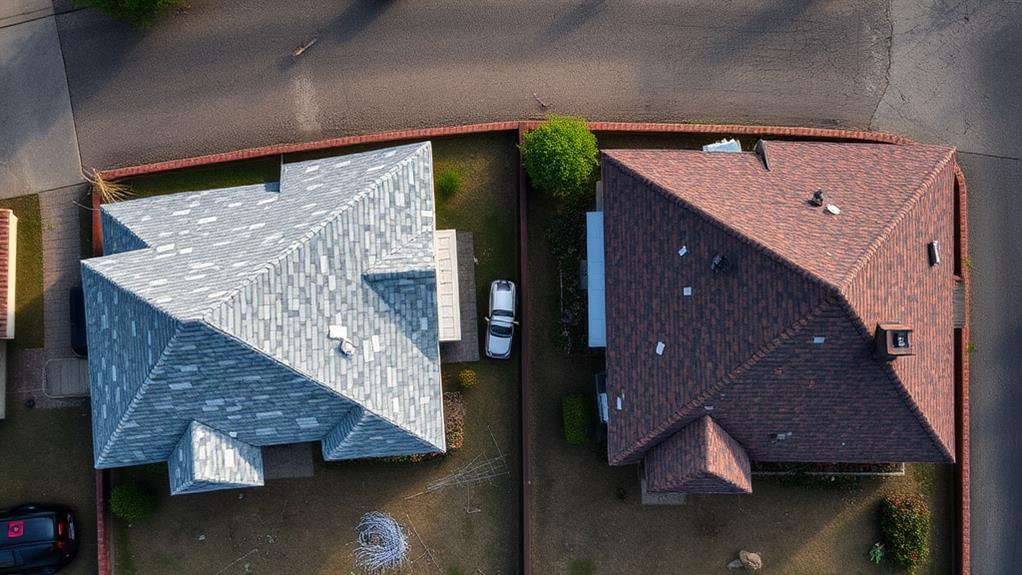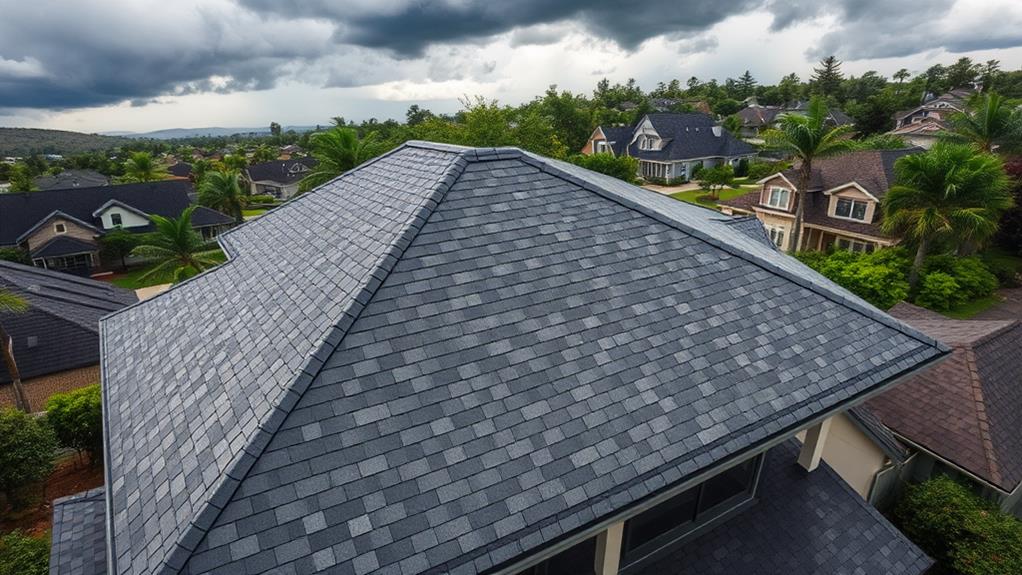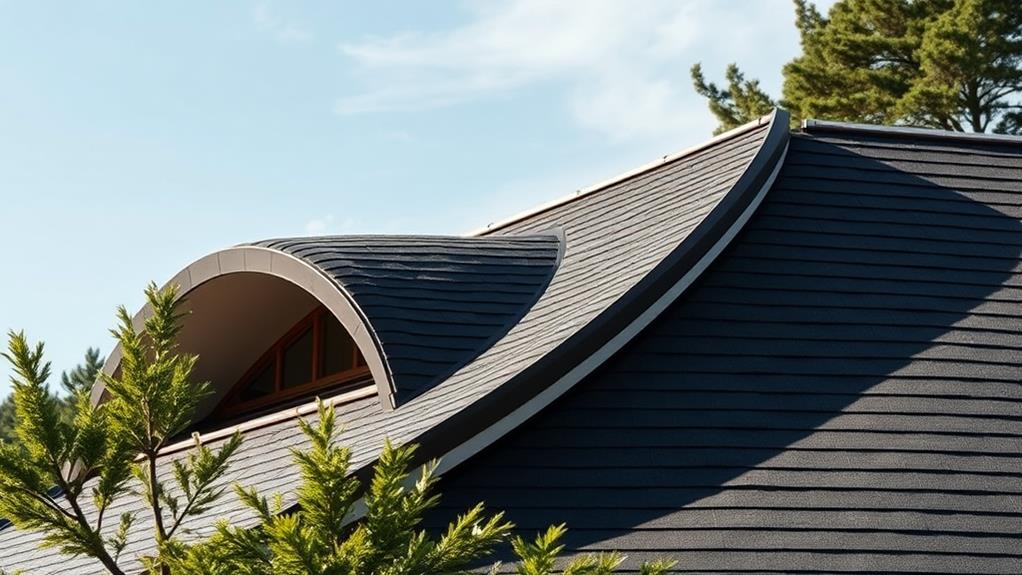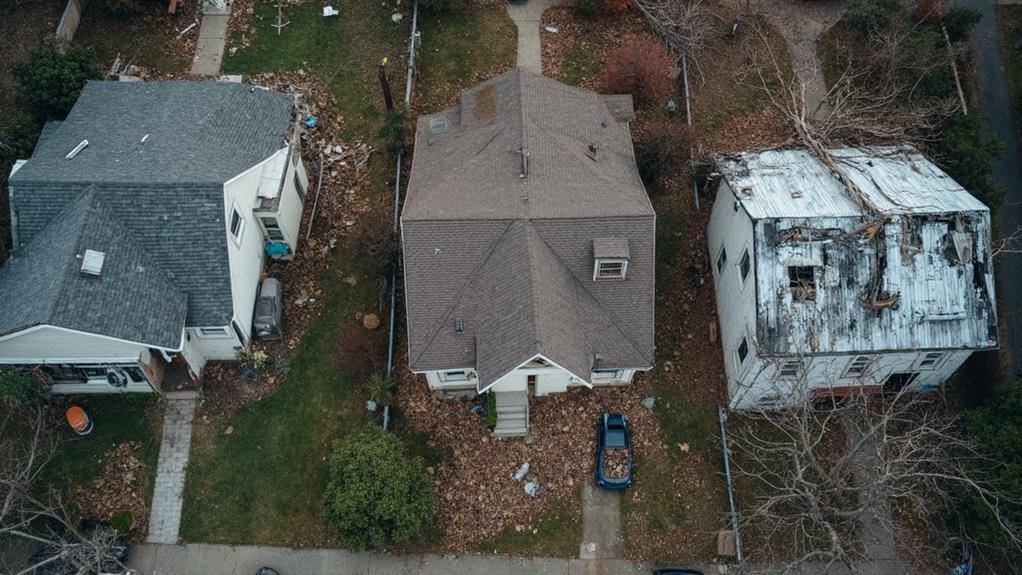Recent storms have highlighted the critical importance of wind-resistant roofing in protecting buildings from severe weather. Key lessons include the need for advanced materials, innovative installation techniques, and aerodynamic design principles. Traditional roofing vulnerabilities, such as inadequate fastening and poorly secured edges, have been exposed. Manufacturers now offer impact-resistant shingles, synthetic underlayments, and high-performance sealants to enhance wind resistance. Proper installation techniques, including six-nail fastening patterns and hurricane clips, significantly improve roof performance. Aerodynamic designs and rigorous testing standards further bolster wind resistance. While initial costs may be higher, the long-term benefits of wind-resistant roofing include reduced damage, lower insurance premiums, and increased property value. Further exploration reveals additional insights into this crucial aspect of building protection.
Understanding Wind's Impact on Roofs

Wind unleashes powerful forces on roofing systems, posing significant challenges to their structural integrity. As air flows over a roof's surface, it creates areas of positive and negative pressure. The windward side experiences positive pressure, pushing upward on the roof, while the leeward side and corners endure negative pressure, potentially lifting roofing materials. This pressure differential can cause shingles to peel back, tiles to dislodge, or entire sections to detach.
The severity of wind damage depends on various factors, including wind speed, duration, direction, and roof geometry. Steep-sloped roofs generally perform better than low-slope ones, as they allow wind to pass over more easily. However, even well-designed roofs can succumb to extreme wind events, such as hurricanes or tornadoes.
Wind-driven debris poses an additional threat, potentially puncturing roofing materials and compromising the roof's water-shedding ability.
Understanding these wind dynamics is crucial for developing effective wind-resistant roofing strategies. Engineers and manufacturers continually refine roofing systems to better withstand wind forces, incorporating stronger fasteners, improved sealants, and wind-resistant edge details. Regular maintenance and inspections are also vital to ensure roofs remain capable of resisting wind damage over time.
Key Vulnerabilities in Traditional Roofing
Traditional roofing systems exhibit several key vulnerabilities when faced with strong winds. The most common weak points include inadequate fastening of shingles or tiles, poorly secured roof edges and corners, and insufficient attachment of the roof deck to the building structure. Shingles can be easily lifted and torn off by high winds, especially if they are old or improperly installed. The edges and corners of roofs experience higher wind pressures and are particularly susceptible to damage if not properly reinforced.
Another significant vulnerability is the potential for water infiltration. When wind-driven rain accompanies strong gusts, it can force water under loose shingles or through gaps in flashing, leading to leaks and interior damage. Roof vents, chimneys, and other protrusions are also weak points, as they can create wind turbulence and provide entry points for water. Additionally, inadequate attic ventilation can lead to pressure differentials during storms, potentially causing the roof to lift or separate from the structure. Addressing these vulnerabilities is crucial for improving a roof's wind resistance and overall performance during severe weather events.
Advanced Materials for Wind Resistance

To address the vulnerabilities of traditional roofing systems, manufacturers and researchers have developed advanced materials specifically designed to enhance wind resistance. These innovative solutions focus on improving the strength, flexibility, and cohesion of roofing components to withstand high winds and flying debris.
One significant advancement is the development of impact-resistant shingles, which incorporate polymer-modified asphalt or reinforced fiberglass to increase durability. These shingles are often tested to withstand wind speeds up to 130 mph and resist damage from hailstones.
Another breakthrough is the use of synthetic underlayments, which provide superior water resistance and tear strength compared to traditional felt paper.
Adhesive technologies have also improved, with high-performance sealants and tapes designed to create a stronger bond between roofing elements. These adhesives maintain flexibility in extreme temperatures, reducing the risk of shingle lift-off during storms.
Additionally, metal roofing systems with interlocking panels and concealed fasteners offer excellent wind resistance, often rated for winds up to 180 mph.
Lastly, advanced polymer membranes used in low-slope roofing applications provide enhanced puncture resistance and flexibility, minimizing the risk of tearing or separation during high winds.
Innovative Installation Techniques
Alongside the development of advanced materials, innovative installation techniques play a crucial role in enhancing wind resistance for roofing systems. Recent advancements focus on improving the attachment methods and overall structural integrity of roofs to withstand high winds.
One notable technique is the use of ring-shank nails, which provide superior holding power compared to traditional smooth-shank nails. These nails have circular ridges along the shaft, increasing friction and resistance to pull-out. Another innovation is the implementation of hurricane clips or straps, which secure roof trusses or rafters to the wall plates, creating a continuous load path from the roof to the foundation.
Improved sealing methods have also emerged, such as the application of peel-and-stick underlayment along eaves, rakes, and valleys. This technique provides an additional water barrier and helps prevent wind-driven rain infiltration. Furthermore, the adoption of six-nail fastening patterns for shingles, instead of the standard four-nail approach, significantly enhances wind uplift resistance.
Proper installation of drip edges and starter strips is now emphasized, ensuring these components are securely fastened to resist wind forces. Additionally, the use of impact-resistant synthetic underlayments provides an extra layer of protection against wind-borne debris.
Aerodynamic Design Principles

Aerodynamic design principles have emerged as a critical factor in developing wind-resistant roofing systems. These principles focus on reducing wind uplift forces and minimizing turbulence around roof structures.
Key strategies include incorporating low-slope designs, rounded edges, and streamlined profiles to decrease wind resistance and pressure differentials.
Wind tunnel testing and computational fluid dynamics simulations play crucial roles in optimizing roof shapes and configurations. These methods allow engineers to identify areas of high wind pressure and develop solutions to mitigate potential damage.
Aerodynamic features such as spoilers, baffles, and vortex generators can be strategically placed to disrupt airflow patterns and reduce lift forces on roof surfaces.
The integration of these design principles extends beyond the roof itself to encompass the entire building envelope. Considerations include the positioning of roof penetrations, the design of parapets and overhangs, and the selection of roofing materials with appropriate wind ratings.
Testing and Certification Standards
Rigorous testing and certification standards form the backbone of wind-resistant roofing development and implementation. These standards, established by organizations like ASTM International and FM Global, ensure that roofing systems meet specific performance criteria under simulated wind conditions.
Wind uplift resistance tests, such as ASTM E1592 and UL 580, subject roofing assemblies to controlled pressure differentials, mimicking real-world wind forces. These tests evaluate the roof's ability to withstand negative pressure and maintain structural integrity.
Additionally, impact resistance testing, as outlined in UL 2218, assesses a roof's capacity to withstand hail and wind-borne debris.
Certification programs, like Miami-Dade County's Notice of Acceptance (NOA) and Texas Department of Insurance's (TDI) evaluation reports, provide comprehensive assessments of roofing products' wind resistance capabilities. These programs often require a combination of laboratory testing and field performance evaluations.
Manufacturers must continually adapt their products to meet evolving standards, which are regularly updated based on post-storm damage assessments and advancements in building science. Compliance with these standards not only ensures better protection for buildings but also often translates to insurance premium reductions for property owners.
Cost-Benefit Analysis of Wind-Resistant Roofing

While stringent testing and certification standards ensure the quality of wind-resistant roofing systems, property owners and developers must carefully weigh the financial implications of implementing these advanced solutions. The initial investment in wind-resistant roofing materials and installation can be significantly higher than traditional roofing options. However, the long-term benefits often outweigh these upfront costs.
A comprehensive cost-benefit analysis should consider factors such as reduced insurance premiums, lower maintenance expenses, and decreased likelihood of catastrophic damage during severe weather events. In regions prone to high winds and hurricanes, the potential savings from avoided repairs and replacements can be substantial. Additionally, wind-resistant roofing may increase property value and marketability, particularly in areas where storm resilience is a key concern for buyers.
Governments and insurance companies sometimes offer incentives or discounts for installing wind-resistant roofing, further improving the cost-benefit ratio. Property owners should also factor in the potential for business continuity and reduced downtime following storms, which can have significant economic implications. Ultimately, the decision to invest in wind-resistant roofing should be based on a thorough assessment of local climate risks, building codes, and long-term financial projections.
Frequently Asked Questions
How Long Does Wind-Resistant Roofing Typically Last Compared to Traditional Roofing?
Wind-resistant roofing typically lasts 25-30 years, compared to 15-20 years for traditional roofing. The enhanced durability and materials used in wind-resistant designs contribute to their longer lifespan, offering better protection against severe weather conditions.
Can Existing Roofs Be Retrofitted for Improved Wind Resistance?
Like fortifying a castle's defenses, existing roofs can indeed be retrofitted for improved wind resistance. Techniques include reinforcing roof-to-wall connections, upgrading fasteners, installing hurricane straps, and applying high-wind-rated shingles or metal panels over existing materials.
Are There Specific Insurance Benefits for Installing Wind-Resistant Roofing?
Many insurance companies offer policy discounts for wind-resistant roofing installations. These benefits may include reduced premiums, lower deductibles, or increased coverage limits. Homeowners should consult their insurance providers to explore specific incentives available in their area.
How Does Wind-Resistant Roofing Perform in Other Extreme Weather Conditions?
Wind-resistant roofing performs well in various extreme weather conditions. It offers enhanced protection against heavy rain, hail, and snow loads. The improved structural integrity and wind uplift resistance also contribute to better overall durability during severe weather events.
Are There Any Aesthetic Limitations to Wind-Resistant Roofing Options?
Wind-resistant roofing options have improved significantly in recent years, offering a wide range of aesthetically pleasing choices. Homeowners can now select from various styles, colors, and materials that meet both structural requirements and design preferences without compromising curb appeal.
Conclusion
In the grand theater of nature, roofs stand as stalwart actors against the tempestuous winds of fate. Like a seasoned warrior donning armor, wind-resistant roofing fortifies structures against elemental assaults. Through advanced materials, innovative techniques, and aerodynamic wisdom, these guardians of shelter evolve. As the storms of climate change intensify, the investment in such defenses becomes not merely prudent, but essential. In this architectural arms race, only the most adaptable and resilient shall weather the gales of tomorrow.

